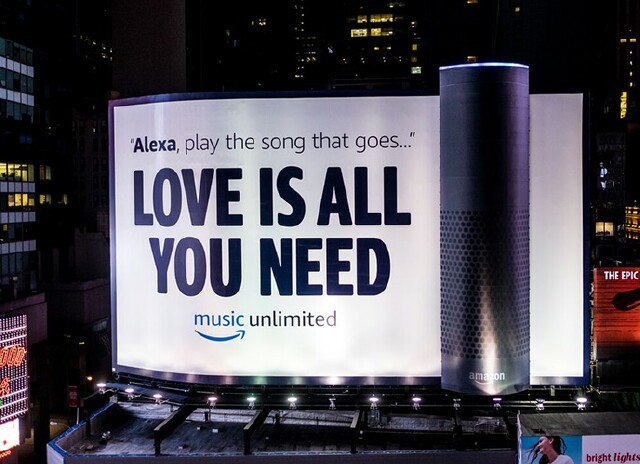The Two Future Mediums of Advertising

Today’s advertising capabilities and the ability to target your audience are greater than they have ever been. So, what has shifted in advertising to make room for a new world view, and what lies ahead?
I imagine a world in the near future where advertisers will have two primary mediums: (1) device-based advertising related to your mobile phone, tablet, wearable or digital voice assistants like Alexa, and (2) out-of-home. In this new world, it will be harder than ever to stand out, and that’s why the art of brand building has to involve interactivity and brand advocacy and will be fundamental to successful advertising campaigns.
I’ve discussed before how the shift in advertising has moved from exposure to engagement and advocacy. Over the last several years, out-of-home (OOH) has added predictive, social and geotargeting abilities, which takes audience targeting one step further by giving brands data on their audience so they can make stronger relevant connections.
Meanwhile, television continues to lose its relevancy, and after years of declining revenues 2019 is predicted to be the year that digital ad revenue outpaces television’s ad revenue. Eventually, digital ads will be displaced by the next emerging platform: voice-enabled devices, which are expected to make their way into more than half of U.S. households by 2022. Advertisers will develop new strategies for voice-enabled devices that not only serve consumers personalized ads but are able to facilitate shared experiences to groups of consumers, the way television had been successful with sports programming, and the way OOH continues to captivate audiences in the wild.
Creating Cohesion in Advertising During the Digital Era
How brands connect with consumers has fundamentally changed over the last 20 years. As advertising targeting has become more sophisticated, consumers have come to expect that their content and advertising is customized, personalized and digitized.
However, few brands are serving the same user experience to their audience. Depending on geolocation, audience demographic and past engagements, different ads are served up to different audiences at different times. And while this does create a more personalized experience, it also leads to a disconnect in a collective experience. Creating a collective experience is essential; it’s what enables a message to become universal, to go viral, or even to become a meme: because we all have the same point of reference to share.
So, what can brands do to create an en masse, shared user experience? Advertisers are finding that OOH is one of the most effective tools to streamline the user experience. When commuters see an ad on the subway, for example, the experience of the ad is not only shared, but is a collective experience. As we shift towards a two-medium world in advertising, the consistency of user experience will be more important than ever to drive messages home to consumers, particularly as we move towards a voice-driven world.
Contextual Relevance and Increasing Engagement in Advertising
As brands design OOH campaigns to be hyperlocal and contextually relevant to their audience, they must also think about driving intent and marketing fulfillment. Whether it’s leveraging data to create location-specific OOH campaigns like Spotify has done to showcase users’ top songs and favorite artists, or making a big statement through station domination on your competitor’s turf, like Pepsi did in Atlanta during the Super Bowl, advertisers are driving engagement by creating moment-in-time events and IRL connections.
Through geofencing, OOH is also able gather anonymous data from your audience. When consumers see an OOH advertisement at an amusement park or at a movie theater, advertisers can glean insights from their audience to refine and create messaging that is more personalized. As this occurs, the user experience becomes more cohesive, and at the same time OOH will also drive continuity in campaigns through advertising that capitalizes on the collective experience.
A recent partnership between navigation app Waze and fast-food chain McDonald’s resulted in an OOH, location and mobile campaign that drove real outcomes for McDonald’s. In an eight-week pilot program in Southern California, more than 300 McDonald’s billboards were geofenced, prompting full-screen ads designed to complement nearby McDonald’s billboards on Waze users phone screens after drivers had stopped for at least four seconds. The campaign prompted 8,400 Waze users to immediately navigate to their nearest McDonald’s and generated more than six million impressions. This serves as an excellent example of the power of combining OOH content, location information and mobile integrations to feed multiple messages and drive consumer engagement.
As we anticipate the rise of voice as a powerful aspect of device-driven advertising, we can imagine a 5G world in the not-so-distant future where a person walking down the street will see a weather update on a digital billboard and ask for more detailed content; or spot an advertisement for a sparkling water brand and ask for the nearest retail location, with information and directions pushed directly to their mobile device. The inherent interactivity of combining OOH and voice technology has the power to allow customers to immediately take action on advertisements, effectively and instantly turning discovery into engagement.
In the future, we will increasingly see how OOH will be the anchor for cross-channel campaigns and inform how the two mediums of device and OOH drive engagement and connect with their audience in more direct and meaningful ways.
Click the social buttons above or below to share this content with your friends and colleagues.
The opinions and points of view expressed in this content are exclusively the views of the author and/or subject(s) and do not necessarily represent the views of MediaVillage.com/MyersBizNet, Inc. management or associated writers.


